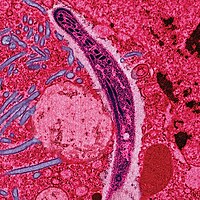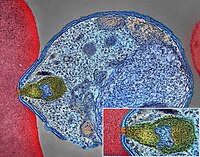
Extensive diversity of malaria parasites circulating in Central African bats and monkeys
Sign Up to like & getrecommendations! Published in 2018 at "Ecology and Evolution"
DOI: 10.1002/ece3.4539
Abstract: Abstract The order Haemosporidia gathers many protozoan parasites which are known to infect many host species and groups. Until recently, the studies on haemosporidian parasites primarily focused on the genus Plasmodium among a wide range… read more here.
Keywords: diversity malaria; diversity; bats monkeys; malaria parasites ... See more keywords

Do avian malaria parasites reduce vector longevity?
Sign Up to like & getrecommendations! Published in 2018 at "Current opinion in insect science"
DOI: 10.1016/j.cois.2018.08.001
Abstract: Avian Plasmodium and malaria-like parasites of the genus Haemoproteus are widespread vector-borne parasites commonly found infecting birds. These parasites impose deleterious effects on their vertebrate hosts compromising their survival. While the interaction between these parasites… read more here.
Keywords: vector; longevity; avian malaria; malaria parasites ... See more keywords

One-pot, multi-component synthesis and structure-activity relationships of peptoid-based histone deacetylase (HDAC) inhibitors targeting malaria parasites.
Sign Up to like & getrecommendations! Published in 2018 at "European journal of medicinal chemistry"
DOI: 10.1016/j.ejmech.2018.09.018
Abstract: Malaria drug discovery has shifted from a focus on targeting asexual blood stage parasites, to the development of drugs that can also target exo-erythrocytic forms and/or gametocytes in order to prevent malaria and/or parasite transmission.… read more here.
Keywords: malaria; asexual blood; histone deacetylase; malaria parasites ... See more keywords

Molecular interactions governing host-specificity of blood stage malaria parasites.
Sign Up to like & getrecommendations! Published in 2017 at "Current opinion in microbiology"
DOI: 10.1016/j.mib.2017.10.006
Abstract: Non-human primates harbor diverse species of malaria parasites, including the progenitors of Plasmodium falciparum and Plasmodium vivax. Cross-species transmission of some malaria parasites-most notably the macaque parasite, Plasmodium knowlesi-continues to this day, compelling the scientific… read more here.
Keywords: host specificity; blood; malaria parasites; host ... See more keywords

Novel Defense Peptides from Platelets Kill Malaria Parasites.
Sign Up to like & getrecommendations! Published in 2018 at "Trends in parasitology"
DOI: 10.1016/j.pt.2018.07.013
Abstract: PF4 (platelet factor 4) is the first host defense peptide identified from platelets that kills malaria parasites. In a recent study, a cyclic PF4 derivative, cPF4PD, is developed, which inherits the antiparasitic effect of PF4… read more here.
Keywords: defense; novel defense; defense peptides; malaria parasites ... See more keywords

Can malaria parasites be spontaneously cleared?
Sign Up to like & getrecommendations! Published in 2022 at "Trends in parasitology"
DOI: 10.1016/j.pt.2022.02.005
Abstract: A large body of evidence demonstrates that Plasmodium falciparum infections are chronic in malaria endemic areas; however, the notion of spontaneous clearance in the absence of antimalarial drug treatment is rarely discussed. In this opinion… read more here.
Keywords: malaria parasites; spontaneously cleared; spontaneous clearance; parasites spontaneously ... See more keywords

Malaria parasites do respond to heat.
Sign Up to like & getrecommendations! Published in 2022 at "Trends in parasitology"
DOI: 10.1016/j.pt.2022.02.009
Abstract: The capacity of malaria parasites to respond to changes in their environment at the transcriptional level has been the subject of debate, but recent evidence has unambiguously demonstrated that Plasmodium spp. can produce adaptive transcriptional… read more here.
Keywords: malaria parasites; response; parasites respond; respond heat ... See more keywords

Changes in genome organization of parasite-specific gene families during the Plasmodium transmission stages
Sign Up to like & getrecommendations! Published in 2018 at "Nature Communications"
DOI: 10.1038/s41467-018-04295-5
Abstract: The development of malaria parasites throughout their various life cycle stages is coordinated by changes in gene expression. We previously showed that the three-dimensional organization of the Plasmodium falciparum genome is strongly associated with gene… read more here.
Keywords: gene families; gene expression; specific gene; malaria parasites ... See more keywords

The transcriptional regulator HDP1 controls expansion of the inner membrane complex during early sexual differentiation of malaria parasites.
Sign Up to like & getrecommendations! Published in 2022 at "Nature microbiology"
DOI: 10.1038/s41564-021-01045-0
Abstract: Transmission of Plasmodium falciparum and other malaria parasites requires their differentiation from asexual blood stages into gametocytes, the non-replicative sexual stage necessary to infect the mosquito vector. This transition involves changes in gene expression and… read more here.
Keywords: hdp1; early sexual; malaria parasites; malaria ... See more keywords

CRISPR/Cas9 and genetic screens in malaria parasites: small genomes, big impact
Sign Up to like & getrecommendations! Published in 2022 at "Biochemical Society Transactions"
DOI: 10.1042/bst20210281
Abstract: The ∼30 Mb genomes of the Plasmodium parasites that cause malaria each encode ∼5000 genes, but the functions of the majority remain unknown. This is due to a paucity of functional annotation from sequence homology, which… read more here.
Keywords: crispr cas9; screens malaria; malaria parasites; genetic screens ... See more keywords

Direct tests of cytochrome c and c1 functions in the electron transport chain of malaria parasites.
Sign Up to like & getrecommendations! Published in 2023 at "Proceedings of the National Academy of Sciences of the United States of America"
DOI: 10.1073/pnas.2301047120
Abstract: The mitochondrial electron transport chain (ETC) of Plasmodium malaria parasites is a major antimalarial drug target, but critical cytochrome (cyt) functions remain unstudied and enigmatic. Parasites express two distinct cyt c homologs (c and c-2) with… read more here.
Keywords: cytochrome functions; transport chain; electron transport; malaria parasites ... See more keywords